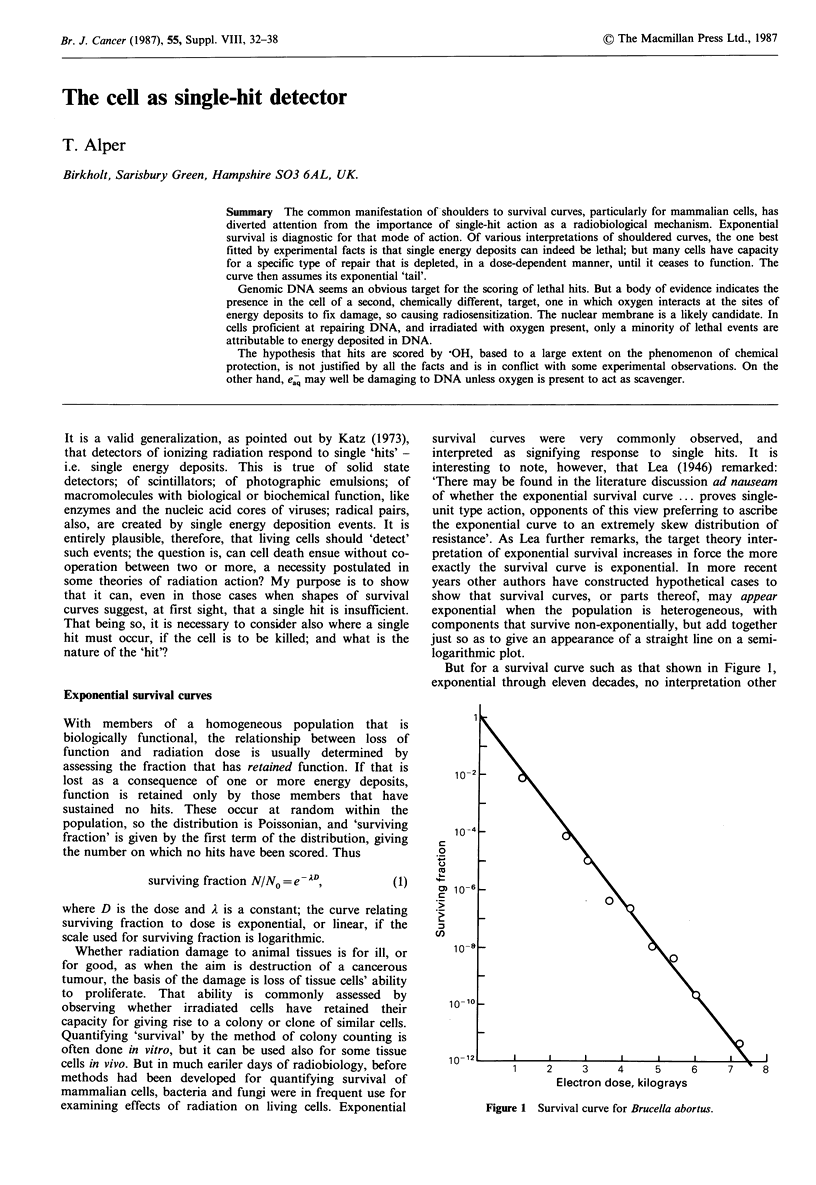Abstract
The common manifestation of shoulders to survival curves, particularly for mammalian cells, has diverted attention from the importance of single-hit action as a radiobiological mechanism. Exponential survival is diagnostic for that mode of action. Of various interpretations of shouldered curves, the one best fitted by experimental facts is that single energy deposits can indeed be lethal; but many cells have capacity for a specific type of repair that is depleted, in a dose-dependent manner, until it ceases to function. The curve then assumes its exponential 'tail'. Genomic DNA seems an obvious target for the scoring of lethal hits. But a body of evidence indicates the presence in the cell of a second, chemically different, target, one in which oxygen interacts at the sites of energy deposits to fix damage, so causing radiosensitization. The nuclear membrane is a likely candidate. In cells proficient at repairing DNA, and irradiated with oxygen present, only a minority of lethal events are attributable to energy deposited in DNA. The hypothesis that hits are scored by .OH, based to a large extent on the phenomenon of chemical protection, is not justified by all the facts and is in conflict with some experimental observations. On the other hand, e-aq may well be damaging to DNA unless oxygen is present to act as scavenger.
Full text
PDF




Selected References
These references are in PubMed. This may not be the complete list of references from this article.
- Cox R., Thacker J., Goodhead D. T. Inactivation and mutation of cultured mammalian cells by aluminium characteristic ultrasoft X-rays. II. Dose-responses of Chinese hamster and human diploid cells to aluminium X-rays and radiations of different LET. Int J Radiat Biol Relat Stud Phys Chem Med. 1977 Jun;31(6):561–576. doi: 10.1080/09553007714550661. [DOI] [PubMed] [Google Scholar]
- Cramp W. A. Radiation protection of Shigella flexneri Y6R by ethanol, beta-mercaptoethanol and several polyhydric alcohols. Int J Radiat Biol Relat Stud Phys Chem Med. 1969 May;15(3):227–232. doi: 10.1080/09553006914550401. [DOI] [PubMed] [Google Scholar]
- Durand R. E., Sutherland R. M. Effects of intercellular contact on repair of radiation damage. Exp Cell Res. 1972 Mar;71(1):75–80. doi: 10.1016/0014-4827(72)90265-0. [DOI] [PubMed] [Google Scholar]
- GINOZA W., NORMAN A. Radiosensitive molecular weight of tobacco mosaic virus nucleic acid. Nature. 1957 Mar 9;179(4558):520–521. doi: 10.1038/179520a0. [DOI] [PubMed] [Google Scholar]
- GORDY W., MIYAGAWA I. Electron spin resonance studies of mechanisms for chemical protection from ionizing radiation. Radiat Res. 1960 Mar;12:211–229. [PubMed] [Google Scholar]
- Gould M. N., Biel W. F., Clifton K. H. Morphological and quantitative studies of gland formation from inocula of monodispersed rat mammary cells. Exp Cell Res. 1977 Jul;107(2):405–416. doi: 10.1016/0014-4827(77)90362-7. [DOI] [PubMed] [Google Scholar]
- Gould M. N., Cathers L. E., Clifton K. H., Howard S., Jirtle R. L., Mahler P. A., Mulcahy R. T., Thomas F. The influence of in situ repair systems on survival of several irradiated parenchymal cell types. Br J Cancer Suppl. 1984;6:191–195. [PMC free article] [PubMed] [Google Scholar]
- Henle K. J., Leeper D. B. The modification of radiation damage in CHO cells by hyperthermia at 40 and 45 degrees C1. Radiat Res. 1977 May;70(2):415–424. [PubMed] [Google Scholar]
- Iliakis G., Nüsse M. Evidence that repair and expression of potentially lethal damage cause the variations in cell survival after X irradiation observed through the cell cycle in Ehrlich ascites tumor cells. Radiat Res. 1983 Jul;95(1):87–107. [PubMed] [Google Scholar]
- Obioha F. I., Gillies N. E., Cullen B. M., Walker H. C., Alper T. Constants of the Alper and Howard-Flanders oxygen equation for damage to bacterial membrane, deduced from observations on the radiation-induced penicillin-sensitive lesion. Int J Radiat Biol Relat Stud Phys Chem Med. 1984 May;45(5):427–437. doi: 10.1080/09553008414550631. [DOI] [PubMed] [Google Scholar]
- POWERS E. L. Considerations of survival curves and target theory. Phys Med Biol. 1962 Jul;7:3–28. doi: 10.1088/0031-9155/7/1/301. [DOI] [PubMed] [Google Scholar]
- PUCK T. T., MARCUS P. I. Action of x-rays on mammalian cells. J Exp Med. 1956 May 1;103(5):653–666. doi: 10.1084/jem.103.5.653. [DOI] [PMC free article] [PubMed] [Google Scholar]
- Sinclair W. K. N-ethylmaleimide and the cyclic response to x-rays of synchronous Chinese hamster cells. Radiat Res. 1973 Jul;55(1):41–57. [PubMed] [Google Scholar]
- Weichselbaum R. R., Epstein J., Little J. B., Kornblith P. L. In vitro cellular radiosensitivity of human malignant tumors. Eur J Cancer. 1976 Jan;12(1):47–51. doi: 10.1016/0014-2964(76)90123-7. [DOI] [PubMed] [Google Scholar]


